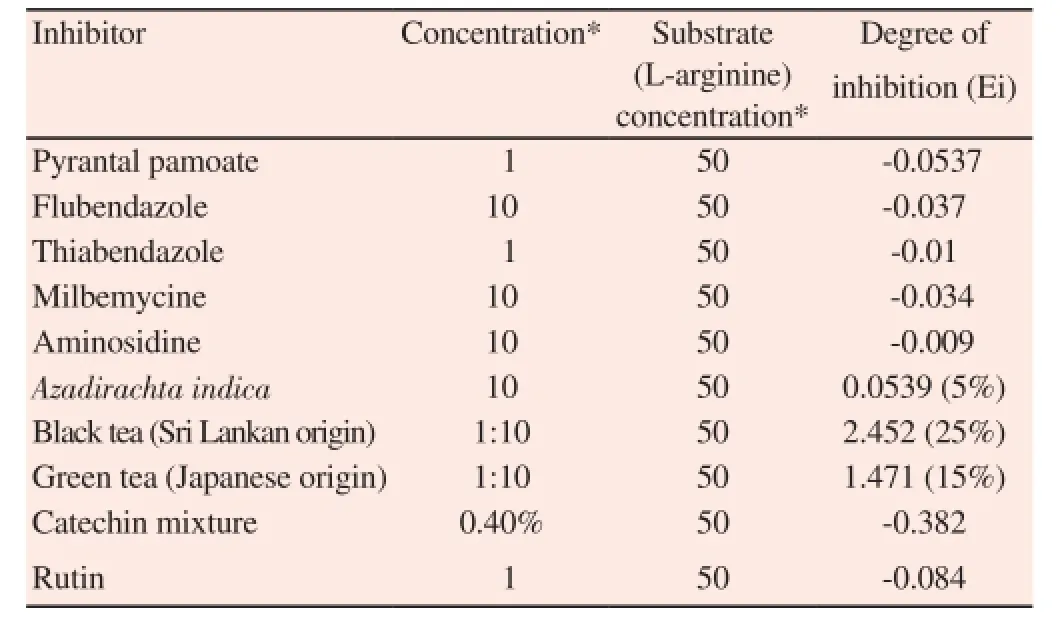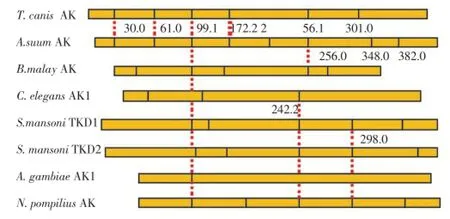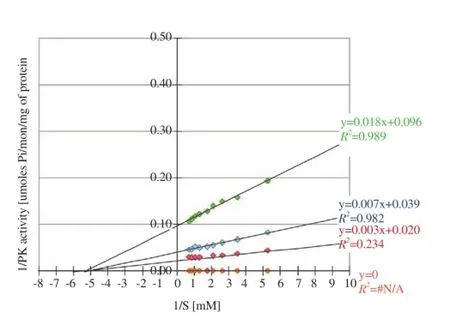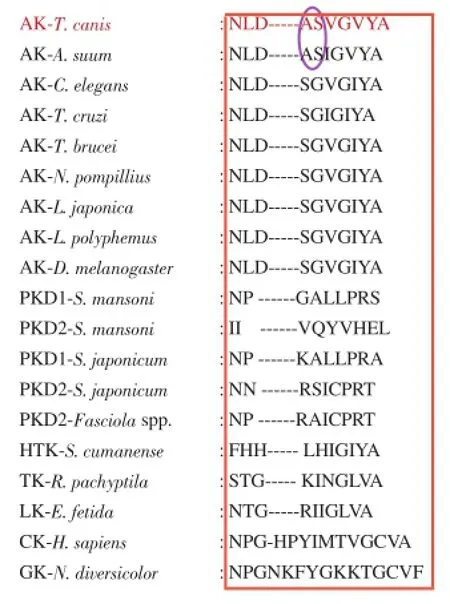Arginine kinase in Toxocara canis: Exon-intron organization, functional analysis of site-directed mutants and evaluation of putative enzyme inhibitors
Susiji Wickramasinghe, Lalani Yatawara, Mitsuru Nagataki, Takeshi Agatsuma
1Department of Parasitology, Faculty of Medicine, University of Peradeniya, Peradeniya 20400, Sri Lanka
2Department of Medical Laboratory sciences, Faculty of Allied Health Sciences, University of Peradeniya, Peradeniya 20400, Sri Lanka
3Department of Environmental Health Sciences, Kochi Medical School, Oko, Nankoku City, Kochi Ken 783-8505, Japan
Arginine kinase in Toxocara canis: Exon-intron organization, functional analysis of site-directed mutants and evaluation of putative enzyme inhibitors
Susiji Wickramasinghe1✉, Lalani Yatawara2, Mitsuru Nagataki3, Takeshi Agatsuma3
1Department of Parasitology, Faculty of Medicine, University of Peradeniya, Peradeniya 20400, Sri Lanka
2Department of Medical Laboratory sciences, Faculty of Allied Health Sciences, University of Peradeniya, Peradeniya 20400, Sri Lanka
3Department of Environmental Health Sciences, Kochi Medical School, Oko, Nankoku City, Kochi Ken 783-8505, Japan
ARTICLE INFO
Article history:
in revised form 15 June 2016
Accepted 15 July 2016
Available online 20 October 2016
Toxocara canis
Arginine kinase
Gene structure
Site directed mutagenesis
Inhibition kinetics
Objective: To determine exon/intron organization of the Toxocara canis (T. canis) AK (TCAK)and to test green and black tea and several other chemicals against the activity of recombinant TCAK in the guanidino-specific region by site-directed mutants. Methods: Amplification of genomic DNA fragments containing introns was carried out by PCRs. The open-reading frame (1 200 bp) of TCAK (wild type) was cloned into the BamH1/SalI site of pMAL-c2X. The maltose-binding protein-TCAK fusion protein was expressed in Escherichia coli TB1 cells. The purity of the expressed enzyme was verified by SDS-PAGE. Mutations were introduced into the guanidino-specific region and other areas of pMAL/TCAK by PCR. Enzyme activity was measured with an NADH-linked assay at 25 ℃ for the forward reaction (phosphagen synthesis). Results: Arginine kinase in T. canis has a seven-exon/six-intron gene structure. The lengths of the introns ranged from 542 bp to 2 500 bp. All introns begin with gt and end with ag. Furthermore, we measured the enzyme activity of site-directed mutants of the recombinant TCAK. The Kmvalue of the mutant (Alanine to Serine) decreased indicating a higher affinity for substrate arginine than the wild-type. The Kmvalue of the mutant (Serine to Glycine)increased to 0.19 mM. The Kmvalue (0.19 mM) of the double mutant (Alanine-Serine to Serine-Glycine) was slightly greater than in the wild-type (0.12 mM). In addition, several other chemicals were tested; including plant extract Azadiracta indica (A. indica), an aminoglycoside antibiotic (aminosidine), a citrus flavonoid glycoside (rutin) and a commercially available catechin mixture against TCAK. Green and black tea (1:10 dilution) produced 15% and 25% inhibition of TCAK, respectively. The extract of A. indica produced 5% inhibition of TCAK. Moreover, green and black tea produced a non-competitive type of inhibition and A. indica produced a mixed-type of inhibition on TCAK. Conclusions: Arginine kinase in T. canis has a seven-exon/six-intron gene structure. However, further studies are needed to identify a specific compound within the extract causing the inhibitory effect and also to determine the molecular mechanisms behind inhibition of arginine kinase in T. canis.
Document heading doi: 10.1016/j.apjtm.2016.07.023
1. Introduction
Arginine kinase (AK) (EC: 2.7.3.3) is a member of the phosphagen kinase family of enzymes widely distributed amongthe invertebrates, protochordates, protozoa and even bacteria[1-8]. Nematode phosphagen kinases are thought to be arginine kinase. Generally, AKs are monomers (40 kDa), but in some cases dimeric and also two-domain AKs resulting from gene duplication and subsequent fusion have been reported[9,10]. AK catalyzes the reversible transfer of phosphate from MgATP to arginine yielding phosphoarginine and MgADP. Thus, AK plays an important role in cellular energy metabolism by maintaining high ATP levels during rapid energy demands such as muscle contraction and motility.Further, guanidines also play a number of other roles including,regulation of glycolysis, glycogenolysis, proton buffering and intracellular energy transport[2,3].
Toxocara canis (T. canis) is a very common round worm found in dogs and cats. Toxocariasis is a global zoonotic disease caused by T. canis (dog round worm) and Toxocara cati (cat round worm). Forms of toxocariasis include visceral larva migrans, covert toxocariasis,ocular larva migrans and spinal form (neurologic). Humans become infected by ingestion of Toxocara infective (embryonated) eggs from contaminated environments[11-14].
In 2007, we published a paper related to molecular cloning,characterization, expression and comparison of the kinetics of cDNA-derived AK of T. canis[2]. Recently, Sahu et al., (2015) have done a similar study and showed 99.8% similarity with the AK gene of T. canis[15]. In our report, we confirmed the type of phoshagen kinase present in T. canis as an arginine kinase and its enzyme kinetics were compared with those of other known AKs. Moreover,analysis of the N-terminus sequence of T. canis AK (TCAK)revealed the presence of a signal targeting peptide, presumably targeting this protein to cytosol or endoplasmic reticulum. In 2008,we reported the development of a highly sensitive IgG-ELISA based on recombinant TCAK for serodiagnosis of visceral larva migrans in the murine model as this enzyme is not present in mammals[16].
Only three gene structures have been reported so far in nematode AKs: Caenorhabditis elegans, Brugia malayi and Ascaris suum[1]. In the present communication, we focus firstly on the determination of the gene structure (exon/intron organization) of TCAK and compare it with other known guanidino kinase gene structures in order to elucidate their diversity in length, position and number. Secondly,we constructed a series of mutants, measured the enzyme activity for the forward reaction or phosphagen synthesis to gain greater understanding of the role of important amino acid residues in the guanidino-specific (GS) region.
Thirdly, several other chemicals/plant extracts were screened to explore possibility of an inhibitory interaction between TCAK and these substances.
2. Materials and methods
2.1. Genomic DNA extraction from T. canis
Genomic DNA was extracted from part of an adult worm using an Easy-DNATM Kit according to the manufactures protocol(Invitrogen Corporation, Carlsbad, CA).
2.2. PCR amplification of introns
Amplification of genomic DNA fragments containing introns was carried out by PCRs using oligonucleotide primers designed from the complementary DNA sequence of T. canis AK[2]. Primer sequences used to amplify introns are given in Table 1. All PCRs were carried out in a final reaction volume of 25 μL. Amplifications were performed with 1 μL of genomic DNA using 1 U Ex Taq Polymerase (Takara Bio Inc., Japan), 10 Ex Taq buffer, 0.2 mM each dNTPs and 10 pmoL of each primer. PCR conditions used were 3 min denaturation at 94 ℃; 30 cycles of 30 s at 94 ℃; 30 s at 55℃ and 5 min at 72 ℃; followed by a final 5 min extension at 68 ℃. All PCR reactions were carried out in a MyCyclerTM Thermal cycler (BioRad, USA). Amplicons were visualized on 1% agarose gels stained with ethidium-bromide. Amplified PCR products were purified in agarose gel using GENECLEAN Ⅱ Kit. Purified PCR products were sub-cloned in pGEMR T-vector system (Promega,USA). Ligated products were transformed into Escherichia coli JM109 cells. Positive clones were obtained and plasmid DNA extraction was performed using the alkaline SDS method. Nucleotide sequences were determined with an ABI PRISM 3100 Avant DNA sequencer using a Big Dye Terminator v3.1 Cycle Sequencing Kit(Applied Biosystem, CA, USA).

Table 1Primers used to amplify the introns of T. canis AK.
2.3. Expression of wild-type TCAK
TCAK isoform characterized previously by Wickramasinghe et al.,(2007) was used as wild-type TCAK for the current study. It has a theoretical molecular mass of 45 376 Da and an estimated isoelectric point (pⅠ) of 8.38[2]. The open-reading frame (1 200 bp) of TCAK(wild type) was cloned into the BamH1/SalⅠ site of pMAL-c2X(New England Biolabs, MA, USA). The maltose-binding protein-TCAK fusion protein was expressed in Escherichia coli TB1 cells by induction with 1 mM IPTG at 25 ℃ for 24 h. The cells were re-suspended in 5X TE buffer, sonicated, and the soluble protein was extracted. Recombinant fusion protein was purified by affinity chromatography using amylose resin according to the manufactures protocol (New England Biolabs, MA, USA). The purity of the expressed enzyme was verified by SDS-PAGE.

Table 2Intron size and the sequence of exon/intron boundaries of the T. canis AK gene.

Table 3Enzyme kinetics of wild-type and site-directed mutants of T. canis AK.
2.4. Site directed mutagenesis
Mutations were introduced into the GS region and other areas of pMAL/TCAK by PCR using oligonucleotide primers designed based on the ORF of TCAK. The mutation 105 Ala to Ser was introduced using the primer set: TCAK105F1 - AGC GTGGGT GTG TAC GCT CCT GAC and TCAK105R1 - AGA ATC CAA ATT GAA TAT GCC TGA. The mutation 106 Ser to Gly was introduced using the primer set: TCAK106F2 - GGC GTG GGT GTG TAC GCT CCT GAC and TCAK106R2 - AGC ATC CAA ATT GAA TAT GCC TGA. The double mutations 105 Ala to Ser and 106 Ser to Gly were introduced using primer set: TCAK106F2 and TCAK105R1. In addition, the mutation 321 Ser to Ala was introduced using primers: TCAK321F - GCT ACA ATC CGT GCT TCG GTG and TCAK321R - ACC GAG ATT AGT CGG ACA GAA. KOD plus DNA polymerase was used as the amplifying enzyme. The PCR products were digested with Dpn Ⅰ and then products were purified. The kination was performed using T4 polynucleotide kinase (10 units/μL), 5X kinase buffer, 100 mM ATP and purified PCR products (after Dpn Ⅰ digestion) used as a template. Then,DNA was self-ligated using T4 DNA ligase. Finally, all the mutants were sequenced and it was verified that mutation occurred at the right position of TCAK. The mutated proteins were expressed and purified as described above.
2.5. Enzyme assay
Enzyme activity was measured (Ultrospec 2100 Pro, UV/Visible Spectrophotometer, Amersham, Biosciences) with an NADH-linked assay at 25 ℃ for the forward reaction (phosphagen synthesis)[21]. Protein concentration was estimated from the absorbance at 280 nm (0.77 AU at 280 nm in a 1 cm cuvette corresponds to 1 mg protein/mL). The Km(Arg) value was determined from the enzyme reaction using nine different substrate concentrations (4 mM, 6 mM,8 mM, 10 mM, 12 mM, 16 mM, 20 mM, 25 mM, and 30 mM) of L-arginine. To determine the Kd value, the above reactions were done at four different concentrations of ATP (10 mM, 7 mM, 5 mM,and 3 mM). Kiwas determined using diluted inhibitor samples as shown in Table 4. Substrate (L-arginine) concentration was kept at a constant level (50 mM). To estimate kinetic constants (Km, Kiand Kcat), a Lineweaver-Burk plot was made and fitted by the leastsquare method in Microsoft Excel.

Table 4Rate of inhibition on TCAK (mM).
2.6. Preparation of aqueous green and black tea for inhibition studies
Commercially available Japanese green and Sri Lankan black tea(2 g in each case) of Camellia sinensis were added separately to (15-25) mL of boiled water and left for (5-10) min. Then, mixtures were filtered and precipitate was removed. The aqueous extracts were stored at -20 ℃ until use. Diluted (1:5, 1:10, 1:25, 1:40, and 1:50)green and black tea extracts were used in the experiments.
2.7. Other products used in the inhibition studies
We tested several other commercially available chemicals such as anthelmintics (pyrantel pamoate (1 mM), flubendazole (1 mM),thiabendazole (15 mM) and milbemycin (10 mM), plant extract Azadiracta indica (A. indica) (0.3%-2%), an aminoglycoside antibiotic aminosidine (0.1 M), a citrus flavonoid glycoside (rutin, 1 mM) and a commercially available catechin mixture (1:2.5 dilution)(containing epicatechin, epicatechingallate, epigallocatechin and epigallocatechingallate) against the TCAK. The enzyme activity was measured using each substance separately and the data recorded. Compounds such as anthelmintics, antibiotics and plant extract (A. indica) were used to evaluate the inhibition kinetics against putative arginine kinase for the first time in the present study. However, green tea and rutin have been used to elucidate the inhibitory activities against AK previously.
3. Results
3.1. Exon/intron organization of T. canis AK
The exon/intron organization of TCAK was determined by PCR amplifications using TCAK specific primers. TCAK has the sevenexon/six-intron gene structure. Lengths of the introns ranged from 542 bp to 2 500 bp. All the introns began with gt and ended with ag(Figure 1 and Table 2).

Figure 1. Comparison of the exon/intron organization (gene structure) of TCAK.
3.2. Kinetic constants and Vmaxof site-directed mutants
We introduced site-directed mutants to the GS region of TCAK and compared the enzyme activity of mutants with that of the wild-type TCAK. The kinetic constants, KmArg, KdArgand Vmaxwere determined. The Kmvalues for single mutants (Ala to Ser) and (Ser to Gly)were 0.07 mM and 0.19 mM respectively. The Kmvalue for double mutant (Ala-Ser to Ser-Gly) was 0.19 mM. The KdArgand Vmaxvalues for single and double mutants were 0.28 mM, 0.28 mM, 0.30 mM and 35.8, 48.9, 43.7 μPi/min/mg/protein respectively. In addition,Kd
Arg/KmArgand KdATP/KmATPvalues were determined for the forward reaction (Table 3).
3.3. Inhibition by green and black tea on the activity of TCAK
Green and black tea (1:10 dilution) produced 15% and 25% inhibition of TCAK respectively. Further, the extract of A. indica has 5% inhibition on TCAK. However, other chemicals used in this study did not cause inhibition of TCAK (Table 4).
3.4. Determination of the inhibition type of green and black tea on TCAK
Figure 2 and Figure 3 show the plots obtained for green and black tea inhibition respectively. These results clearly indicated that the non-competitive type of inhibition occurred during the reactions with both, the green and black tea.

Figure 2. Lineweaver-Burk plots for inhibition of TCAK activity by green tea.

Figure 3. Lineweaver-Burk plots for inhibition of TCAK activity by black tea.
3.5. Inhibition by other products on the activity of TCAK
In addition, we tested several other chemicals such as anthelmintics(pyrantel pamoate, flubendazole, thiabendazole and milbemycin),plant extract (A. indica), an aminoglycoside antibiotic (aminosidine),a citrus flavonoid glycoside (rutin) and a commercially available catechin mixture (containing epicatechin, epicatechingallate,epigallocatechin and epigallocatechingallate) against TCAK. Out of these chemicals only A. indica exerts moderate inhibition (5%)on TCAK (Table 4) and produced mixed-type inhibition during thereaction (Figure 4).

Figure 4. Lineweaver-Burk plots for inhibition of TCAK activity by A. indica.

Figure 5. Amino acid sequence alignment of GS region of T. canis AK with other phosphagen kinases.
4. Discussion
4.1. Comparison of exon/intron organization of T. canis AK
We compared the gene structure of TCAK gene with those of other AKs from the different phyla such as nematodes, trematodes,protozoa and molluscs. Splice junctions (30.0), (61.0), (99.1), and(172.2) of TCAK are conserved between TCAK and Ascaris suum AK (ASAK). Interestingly, intron position (99.1) is conserved in the ASAK (nematode), BMAK (nematode), Caenorhabditis elegans AK1 (nematode), Schistosoma mansoni (trematode) two-domain TK (SMTKD1 and SMTKD2), Nautilus pompilius (mollusc) AK(NMAK) and Anopheles gambiae (Arthropoda) AK1. Further, the intron position (256.0) is conserved between ASAK and BMAK. However, this splice junction differs only by one nucleotide compared to TCAKs intron position (256.1). Trypanosoma cruzi(T. cruzi) (protozoa) has no introns, supporting the idea that it was gained by horizontal gene transfer. In addition, it was reported that two-domain AK genes have a bridge intron which separates the domain one from domain two[17-19]. The structure of AK genes is highly conserved among molluscs (six-exons and five introns)[20]. Similarly, studies on the exon/intron organization of cytoplasmic and mitochondrial creatine kinases have shown that splice junctions are highly conserved. In the present study, we provided further evidence that the AK gene structures from nematodes are highly diverse. For instance, TCAK and ASAK have the seven-exon/six intron and nineexon/eight intron gene structures respectively, whereas BMAK has the six-exon/five-intron structure[1]. In addition, a number of introns and the splice junctions are less conserved among the nematodes studied thus far. A recent study revealed that AK gene family of the suborder Rhabditina has undergone widespread intron loss and gain. Moreover, they have found evidence for gene duplication and loss in Caenorhabditis elegans[21]. These results suggest that a frequent loss or gain of introns has occurred during the process of phosphagen kinase evolution in nematodes.
4.2. Functional analysis of the site-directed mutants
The GS region, which is variable in length, is a possible candidate for the guanidine-recognition site. There is a proportional relationship between the length of the GS region in phosphagen kinases and the mass of the guanidine substrate. For instance, GK which uses the smallest substrate, glycocyamine, has no deletion. CK has only one amino acid deletion. LK, TK and AK each have five amino acid deletions in this region and each recognizes relatively large guanidine substrates[22]. Interestingly, SMTK and Paragonimus westermani TK each has six amino acid deletions leading to the suggestion that taurocyamine might not be the physiological phosphagen substrate for the S. mansoni PK gene[23]. Nevertheless, amino acid residues on the GS region are relatively conserved in the AKs. But the amino acid residues Ala 110 and 111 Ser in the GS region of TCAK differ from conserved amino acid residues. Therefore, we introduced site-directed mutants to the GS region of TCAK and compared the enzyme activity of mutants with that of the wild-type TCAK. The Kmvalue for the mutant (Ala toSer) decreased, indicating a higher affinity for substrate arginine than the wild-type. In contrast, the Kmvalue for the mutant (Ser to Gly) increased to 0.19 mM. Further, compared to the wild-type (0.12 mM), the Kmvalue (0.19 mM) for the double mutant (Ala-Ser to Ser-Gly) also slightly increased. Single mutant (Ala to Ser) shows a higher (4) synergism (KdArg/KmArg) compared to wild type (1.96). The Vmaxvalue is highest (48.9 μPi/min/mg/protein) in the mutant (Ser to Gly) and lowest (35.8 μPi/min/mg/protein) in (Ala to Ser).
4.3. Inhibition by green and black tea on the activity of TCAK
Phosphagen kinases play a vital role in intracellular energy metabolism acting as a reservoir for ATP during periods in which there is disequilibrium of ATP supply and demand. This group of enzymes also plays a number of other roles, including regulation of glycogenolysis, proton buffering and intracellular energy transport[2]. In the present study, we evaluated the effects of green and black tea on TCAK. Green and black tea (1:10 dilution) produced 15% and 25% inhibition of TCAK respectively. Further, the extract of A. indica has 5% inhibition on TCAK. However, other chemicals used in this study did not cause inhibition of TCAK. The higher rate of inhibition by black tea (in comparison with green tea) might be due to its high content of poly phenols and other flavonoids. However, further studies are needed to identify a specific compound within the extract causing the inhibitory effect. A similar study was carried out by Paveto et al., (2004) using green tea catechins against two different developmental stages of T. cruzi[24]. The activity of the catechins on the recombinant arginine kinase of T. cruzi was assayed. The activity of T. cruzi AK was inhibited by about 50 % at nanomolar concentrations of catechingallate or gallocatechingallate. However, other catechins were less effective against T. cruzi AK.
4.5. Inhibition by other products on the activity of TCAK
We found that other chemicals used in the study (except A. indica)did not cause inhibition of the activity of TCAK. However, A. indica exerts moderate inhibition (5%) on TCAK. Therefore, we determined the inhibition type using dilute samples of plant extract (A. indica)and found that these produced mixed-type inhibition of TCAK. Moreover, Wu et al., (2009) investigated the inhibitory interaction between rutin and locust AK using fluorescence spectroscopy and molecular docking[25]. The results of their study indicate that rutin inhibits locust AK and the type of inhibition is noncompetitive. However, in this study we found that rutin did not cause inhibition of the activity of TCAK.
Arginine kinase in T. canis has a seven-exon/six-intron gene structure. Gene structures of nematode AKs are highly divergent and variable, suggesting a frequent loss and gain of introns during the course of arginine kinase evolution. Green and black tea (1:10 dilution) produced about 15% and 25% inhibition of TCAK respectively. The extract of A. indica produced 5% inhibition of TCAK. Furthermore, green and black tea produced a noncompetitive type of inhibition and A. indica produced a mixedtype of inhibition on TCAK. However, further studies are needed to identify a specific compound within the extract causing the inhibitory effect and also to determine the molecular mechanisms behind the inhibition of arginine kinase in T. canis.
Conflict of interest statement
The authors declare that they have no conflict of interests.
4.4. Determination of the inhibition type of green and black tea on TCAK
Acknowledgments
Furthermore, we determined the type of inhibition using a serial dilution (1:10, 1:25, and 1:50) of green and black tea against the different concentrations of substrate arginine (4, 6, 8, 10, 12, 16, 20,25 and 30 mM) under a fixed concentration of ATP (50 mM) and Lineweaver-Burk plots for green and black tea were constructed. These results clearly indicated that the non-competitive type of inhibition occurred during the reactions with both, the green and black tea. On the basis of these results, we suggest that both green and black tea inhibit recombinant TCAK in vitro substantially and they may have antiparasitic properties.
The authors would like to thank Prof. David Blair, James Cook University, Australia for his invaluable comments.
[1] Nagataki M, Uda K, Jarilla BR, Tokuhiro S, Wickramasinghe S, Suzuki T, Blair D, et al. Molecular and catalytic properties of an arginine kinase from the nematode Ascaris suum. J Helminthol 2012; 86(3): 276-286.
[2] Wickramasinghe S, Uda K, Nagataki M, Yatawara L, Rajapakse RPVJ,Watanabe Y, et al. Toxocara canis: Molecular cloning, characterization,expression and comparison of the kinetics of cDNA-derived argininekinase. Experi Parasitol 2007; 117(2): 124-132.
[3] Jarilla BR, Uda K, Suzuki T, Acosta LP, Urabe M, Agatsuma T. Characterization of arginine kinase from the caenogastropod Semisulcospira libertina, an intermediate host of Paragonimus westermani. J Mollus Stud 2014; 80(4): 444-451.
[4] Jarilla BR, Agatsuma T. Phosphagen kinases of parasites: Unexplored chemotherapeutic targets. Korean J Parasitol 2010; 48(4): 281-284.
[5] Umair S, Knight JS, Bland RJ, Simpson HV. Molecular and biochemical characterisation of arginine kinases in Haemonchus contortus and Teladorsagia circumcincta. Exp Parasitol 2013; 134(3): 362-367.
[6] Tokuhiro S, Uda K, Yano H, Nagataki M, Jarilla BR, Suzuki T, et al. Phosphagen kinase in Schistisoma japonicum: charaterization of its enzymatic properties and determination of its gene structure. Mol Biochem Parasitol 2013; 188(2): 91-98.
[7] Shi XY, Zhang LL, Wu F, Fu YY, Yin SJ, Si YX, et al. Kinetics for Cu2+ induced sepia pharaonis arginine kinase inactivation and aggregation. Int J Biol Macromol 2016; 23(6): 508-517.
[8] Kulathunga DG, Wickramasinghe S, Rajapakse RP, Yatawara L,Jayaweera WR, Agatsuma T. Immunolocalization of arginine kinase(AK) in Toxocara canis, Toxocara vitulorum, and Ascaris lumbricoides. Parasitol Res 2012; 111(2): 663-671.
[9] Suzuki T, Kawasaki Y, Unemi Y, Nishimura Y, Soga T, Kamidochi K, et al. Gene duplication and fusion have occurred frequently in the evolution of phosphagen kinases: a two-domain arginine kinase from the clam Pseudocardium sachalinensis. Biochim Biophys Acta 1998; 1388(1): 253-259.
[10] Compaan DM, Ellington WR. Functional consequences of a gene duplication and fusion event in an arginine kinase. J Exp Biol 2003;206(Pt9): 1545-1556.
[11] Despreaux R, Fardeau C, Touhami S, Brasnu E, Champion E, Paris L, et al. Ocular toxocariasis: clinical features and long-term visual outcomes in adult patients. Am J Ophthalmol 2016; 166: 162-168.
[12] Fialho PM, Corrêa CR. A systematic review of toxocariasis: a neglected but high-prevalence disease in Brazil. Am J Trop Med Hyg 2016; 94(6): 1193-1199.
[13] Deshayes S, Bonhomme J, de La Blanchardière A. Neurotoxocariasis: a systematic literature review. Infection 2016; doi: 10.1007/s15010-016-0889-8.
[14] Silva MB, Amor AL, Santos LN, Galvão AA, Oviedo Vera AV, Silva ES,et al. Risk factors for Toxocara spp. seroprevalence and its association with atopy and asthma phenotypes in school-age children in a small town and semi-rural areas of Northeast Brazil. Acta Trop 2016; doi: 10.1016/ j.actatropica.2016.04.005.
[15] Sahu S, Samanta S, Harish DR, Sudhakar NR, Raina OK, Shantaveer SB, et al. Molecular cloning and characterization of arginine kinase gene of Toxocara canis. J Parasit Dis 2015; 39(2): 211-215.
[16] Wickramasinghe S, Yatawara L, Nagataki M, Takamoto M, Watanabe Y,Rajapakse RPVJ, et al. Development of a highly sensitive IgG-ELISA based on recombinant arginine kinase of Toxocara canis for serodiagnosis of visceral larva migrans in the murine model. Parasitol Res 2008;103(4): 853-858.
[17] Fujimoto N, Tanaka K, Suzuki T. Amino acid residues 62 and 193 play the key role in regulating the synergism of substrate binding in oyster arginine kinase. FEBS Lett 2005; 579(7): 1688-1692.
[18] Pereira CA, Alonso GD, Paveto MC, Iribarren A, Cabanas AML, Torres HN, et al. Trypanosoma cruzi arginine kinase characterization and cloning; A novel energetic pathway in protozoan parasites. J Bio Chem 2000; 275(2): 1495-1501.
[19] Uda K, Fujimoto N, Akiyama Y, Mizuta K, Tanaka K, Ellington WR, et al. Evolution of the arginine kinase gene family. Comp Biochem Physiol 2006; 1(2): 209-218.
[20] Suzuki T, Yamamoto Y. Gene structure of two-domain arginine kinases from Anthopleura japonicus and Pseudocardium sachalinensis. Comp Biochem Physio Part B 2000; 127(4): 513-518.
[21] Fraga D, Aryal M, Hall JE, Rae E, Snider M. Characterization of the arginine kinase isoforms in Caenorhabditis elegans. Comp Biochem Physiol B Biochem Mol Biol 2015; 187: 85-101.
[22] Uda K, Iwai A, Suzuki T. Hypotaurocyamine kinase evolved from a gene for arginine kinase. FEBS Lett 2005; 579(30): 6756-6762.
[23] Jarilla RJ, Tokuhiro S, Nagataki M, Hong SJ, Uda K, Suzuki T, et al. Molecular characterization and kinetic properties of a novel two-domain taurocyamine kinase from the lung fluke Paragonimus westermani. FEBS Lett 2009; 583(13): 2218-2124.
[24] Paveto C, Guida MC, Esteva MI, Martino V, Coussio J, Flawia MM,et al. Anti-Trypanosoma cruzi activity of green tea (Camellia sinensis)catechins. Anti Agent Chemo 2004; 48(1): 69-74.
[25] Wu XQ, Zhu WJ, Lu ZR, Xia Y, Yang JM, Zou F, et al. The effect of rutin on arginine kinase: Inhibition kinetics and thermodynamics merging with docking simulation. Int J Biol Macromol 2009; 44(2): 149-155.
15 May 2016
✉First and corresponding author: Susiji Wickramasinghe, Department of Parasitology, Faculty of Medicine, University of Peradeniya, Galaha Road,Peradeniya, 20400 Sri Lanka.
Tel: +94 77 3114472
E-mail: susijij@pdn.ac.lk; susijijp@yahoo.co.jp
 Asian Pacific Journal of Tropical Medicine2016年10期
Asian Pacific Journal of Tropical Medicine2016年10期
- Asian Pacific Journal of Tropical Medicine的其它文章
- Who should be checked for hepatitis C virus infection in endemic areas?
- Identification and analysis of a processed cytochrome P450 pseudogene of the disease vector Aedes aegypti
- Melaleuca quinquinervia (Cav.) S.T. Blake (Myrtales: Myrtaceae): Natural alternative for mosquito control
- Epidemiology of the outbreak, vectors and reservoirs of cutaneous leishmaniasis in Mali: A systematic review and meta-analysis
- Skin whitening and anti-corrugation activities of glycoprotein fractions from liquid extracts of boiled sea cucumber
- Effect of emodin on mobility signal transduction system of gallbladder smooth muscle in Guinea pig with cholelithiasis
